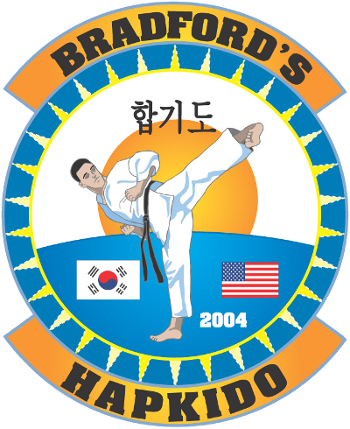Hap - Ki - Do
Loosely translated as 'the way or art of coordinated power'
- Hap: coordination, harmony
- Ki: spirit, power, energy, breath
- Do: the way
General Terms
- Do jang: Academy
- Do bok: Uniform
- Cha-ryut: Attention
- Kyung-ye: Bow
- Choonbi: Ready Position
- Kong-kyuk-zwa sae: Offensive Stance
- Bang-o zwa sae: Defensive Stance
- Baro: Back to Ready
- Shee-yut: Relax
- Si-jak: Begin
- Ke-yo: Stop (temporarily)
- Ki-sa: Begin Again
- Ku-mon: Stop (finish)
- Kub: Grade
- Nae Ki: Inner Power
- Kyuk Pa: Breaking
- Doso Chigi: Hand Technique
- Pakiti: Around
- E-Don: Forward
- Dio: Up
- Hom-bla-nog-a: Step Behind
- Sa Bum Nim: Instructor
- Boo Sa Bum Nim: Assistant Instructor
- Dan: Degree
- Kahm Sahm Ni Da: Thank you
- Saseong: Grand Master (Wise Sage?)
Numbers
Similar to English, there are two different ways to use Korean numbers, as cardinal numbers or as ordinal numbers. Cardinal numbers refer to numbers you use to count with; such as 3 black belts, or 5 kicks. Ordinal numbers refer to something in an order, like your 3rd soolgi technique, or a 1st degree black belt. The counting numbers are used exactly as they sound, while the ordinal numbers can be used in conjuntion with other phrases, such as e-dan referring to 2nd degree black belt, or e-jun referring to a first and second target.
Cardinal Numbers (counting)
- Hana: 1
- Dul: 2
- Set: 3
- Net: 4
- Daset: 5
- Yosut: 6
- Il Gup: 7
- Yo Dol: 8
- Ah Hop: 9
- Yul: 10
Ordinal Numbers
- Il Bon: 1st
- E Bon: 2nd
- Sam Bon: 3rd
- Sa Bon: 4th
- O Bon: 5th
- Yuk Bon: 6th
- Chil Bon: 7th
- Pal Bon: 8th
- Ku Bon: 9th
- Ship Bon: 10th
